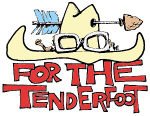|
Website
visitor H.G.F., of Oshkosh, wrote to request that I scan and post the construction
article for the "Thing" lifting body glider. "Thing" is a small 3-D polygonally
shaped craft made from sheet balsa that is 7-1/4" long, 3-1/8" wide, and
3-3/8" high with a glob of modeling clay on the nose for balance. I imagine
it could be scaled up a bit if you want something bigger. "Thing" was designed
in the early 1970s at about the time lifting bodies were a big deal. Recall
(if you were around then) that it was the era of astronaut Steven Austin
and the Six
Million Dollar Man television show. "Thing" Lifting Body Glider
 For
the Tenderfoot For
the TenderfootHigh Performance Angular Re-Entry Vehicle Offers Much
Improvement on Ballistic Flight of Ordinary Shapes. Every Workshop Should
Produce One for the Next Rainy Day. Bill Potter

Top side is flat. A hook could be added near the nose for catapult
launching to orbital velocity.

Small size allows easy storage in desk drawer. This is the view
seen by the oncoming air when Thing is in flight.

This photo shows the bottom view. |
This model originated from the scraps that remained after constructing a
more complex aircraft. Unfortunately, both craft exhibited the same ballistic
characteristics that only can be loosely termed flight. After several years
of playing with Thing, as I affectionately call the creation, I have come
to see several advantages in its design. The age-old modeler's complaint
of warped wings has been cleverly eliminated by eliminating the wings. Because
it is a glider, there is no messy fuel or cantankerous engines to fool with.
Its small size allows storage in a desk drawer. Its peculiar performance
ends the need for a dethermalizer. Construction If you find
the three-view drawing confusing, it is because it is not a three-view.
Only the shapes of the parts are shown, not their relationship. If the plans
are used as three-views, great hardships will result. First, cut
off five 4" lengths of 1/32" balsa sheet. Edge-glue these to form a 4 by
15" sheet with the grain running width wise. Layout the top and back on
this sheet. Layout two sides on the 1/16 sheet, using a razor blade and
a straightedge (or, perhaps, a well-trained beaver) to cut out the pieces.
Keep track of the bottom edge (appropriately labeled "bottom edge" on the
drawing) of both sides. Next, lay a bead of glue along the bottom
edge of one side. (If you're some sort of strength fanatic, you may want
to double glue all joints.) When the glue gets tacky, put the other side
up against it, bottom-edge to bottom-edge. Raise one side (keeping the two
edges in contact) to form an angle of about 110 degrees. At this point,
the model should resemble the tail end of an arrow with one fin missing.
(If it doesn't, start over and keep trying until it does.) Hold the sides
like that until almost dry (meaning the glue, not yourself) and then glue
the back piece to the back end, which is the end opposite the front (pointy)
end. When this mess is dry, glue the top on. You should have something similar
to the pictures. If you don't, study the drawing, pictures, and directions
and start over again. If, by the third try, your model still doesn't look
anything like the pictures, disassemble and try yet again, the parts do
make the "Thing." Finishing Finish your model with several
light coats of nothing. Put a dab of modeling clay on the nose (which, as
mentioned earlier, is the pointy end). For contest use, glue on a piece
of cloth tape along the bottom edge. Materials 1 1/16 x
2 x 36 Balsa Sheet 1 1/32 x 3 x 36 Balsa Sheet 1 Glob of Modeling
Clay Note: Steel plate can be used to produce an exceptionally sturdy
model, but lightweight balsa will increase performance significantly.
Flight Testing Now that you've completed your model, you're
probably wondering what to do with it. In still wind conditions, place the
model in your palm and - with a slight forward push - drop Thing flat. It
should glide merrily away. Try this several times, adding and subtracting
bits of clay to obtain optimum performance - which is about a 2 to 1 glide
ratio. Any turning can be corrected by placing dabs of clay on the side
opposite the turn. The examples I built descended in a slow, flat turn that
was reminiscent of the spaceships landing in the Flash Gordon serials. Maybe
some rich RC flier will create a device that shoots smoke and sparks out
the back while making "nnyeerrt nnyyeeeerrrrtttt" noises for added realism.
Yea Dr. Zarkov!

"Thing" Lifting Body Plans
Notice:
The AMA Plans Service offers a
full-size version of many of the plans show here at a very reasonable cost. They
will scale the plans any size for you. It is always best to buy printed plans because
my scanner versions often have distortions that can cause parts to fit poorly. Purchasing
plans also help to support the operation of the
Academy of Model Aeronautics - the #1
advocate for model aviation throughout the world. If the AMA no longer has this
plan on file, I will be glad to send you my higher resolution version.
Try my Scale Calculator for
Model Airplane Plans.
Posted November 29, 2013
|



